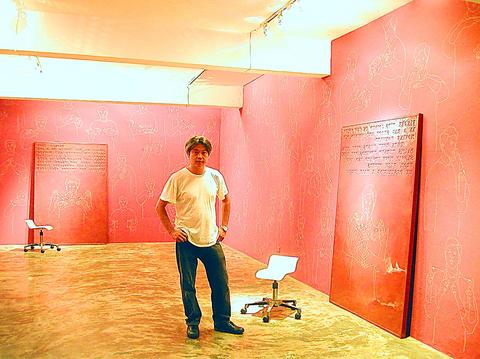I am always wary of people trying to make overlarge statements, and this is what Malaysian-Chinese artist H.H. Lim
One of the first warning signs that Lim's trying to say too much comes in an essay that explains the installation for those who don't "get it," which I'd assume is just about everybody. It says that through this show, Lim intends to "present his views on the world change for the latest year," which included a number of "drastic events, such as New York's 911 tragedy, [the] Israeli war, [the] EU's impact on economics, and natural disasters brought by global climate changes."

A couple of logical nonsequiturs follow, like that since these are problems that "we can only `see' but cannot `speak,'" sign language will be used to specially "interpret" these events (this is a fallacy because sign language expresses thoughts just as any other language does).
To make a quick note of what Lim has done for the exhibition: he has painted the gallery's walls burgundy and on top of that ground has traced textbook style illustrations of generic figures performing sign language in thin, white outlines. There are also several plaques, some picture-sized and hanging on the wall and two two-meters tall and leaning against it. The plaques are embossed with words -- some English and some Italian -- that are printed in reverse so that they could be viewed properly with a mirror.
In all of this language play, Lim seems to be batting at concepts -- much like a blindfolded person bats at a pinata -- from that tirelessly trendy body of thought, post-structural French literary criticism. Specifically, he's bobbling with a paradox of language that goes: the ultimate goal of language is to communicate, but unfortunately, language is an ultimately imperfect tool for communication. So -- and this is what I think he's trying to say -- we have seen a year of extraordinary and calamitous change, but the events themselves were ineffable, and no language we have can adequately express what it means to have seen or experienced them.
But to express that, what he does is put a line drawing of a tank on a wall to represent all the tragedy in all of last year's wars. It is nothing less than incredibly and grossly inadequate. So is juxtaposing against the tank a plaque bearing the word "vedere" (Italian for "to see") and a diagram of how to make the equivalent sign in sign language, all of which is supposed to tell you that seeing these events is the only way of truly understanding them. Basically, it looks like Lim has some big ideas, but he doesn't know how to get them across. So in the end Speechless doesn't say much.
IT Park is located at 2F, 41 Yitung St., Taipei. The exhibit runs through Sept. 28.

On April 26, The Lancet published a letter from two doctors at Taichung-based China Medical University Hospital (CMUH) warning that “Taiwan’s Health Care System is on the Brink of Collapse.” The authors said that “Years of policy inaction and mismanagement of resources have led to the National Health Insurance system operating under unsustainable conditions.” The pushback was immediate. Errors in the paper were quickly identified and publicized, to discredit the authors (the hospital apologized). CNA reported that CMUH said the letter described Taiwan in 2021 as having 62 nurses per 10,000 people, when the correct number was 78 nurses per 10,000

As we live longer, our risk of cognitive impairment is increasing. How can we delay the onset of symptoms? Do we have to give up every indulgence or can small changes make a difference? We asked neurologists for tips on how to keep our brains healthy for life. TAKE CARE OF YOUR HEALTH “All of the sensible things that apply to bodily health apply to brain health,” says Suzanne O’Sullivan, a consultant in neurology at the National Hospital for Neurology and Neurosurgery in London, and the author of The Age of Diagnosis. “When you’re 20, you can get away with absolute

May 5 to May 11 What started out as friction between Taiwanese students at Taichung First High School and a Japanese head cook escalated dramatically over the first two weeks of May 1927. It began on April 30 when the cook’s wife knew that lotus starch used in that night’s dinner had rat feces in it, but failed to inform staff until the meal was already prepared. The students believed that her silence was intentional, and filed a complaint. The school’s Japanese administrators sided with the cook’s family, dismissing the students as troublemakers and clamping down on their freedoms — with

As Donald Trump’s executive order in March led to the shuttering of Voice of America (VOA) — the global broadcaster whose roots date back to the fight against Nazi propaganda — he quickly attracted support from figures not used to aligning themselves with any US administration. Trump had ordered the US Agency for Global Media, the federal agency that funds VOA and other groups promoting independent journalism overseas, to be “eliminated to the maximum extent consistent with applicable law.” The decision suddenly halted programming in 49 languages to more than 425 million people. In Moscow, Margarita Simonyan, the hardline editor-in-chief of the